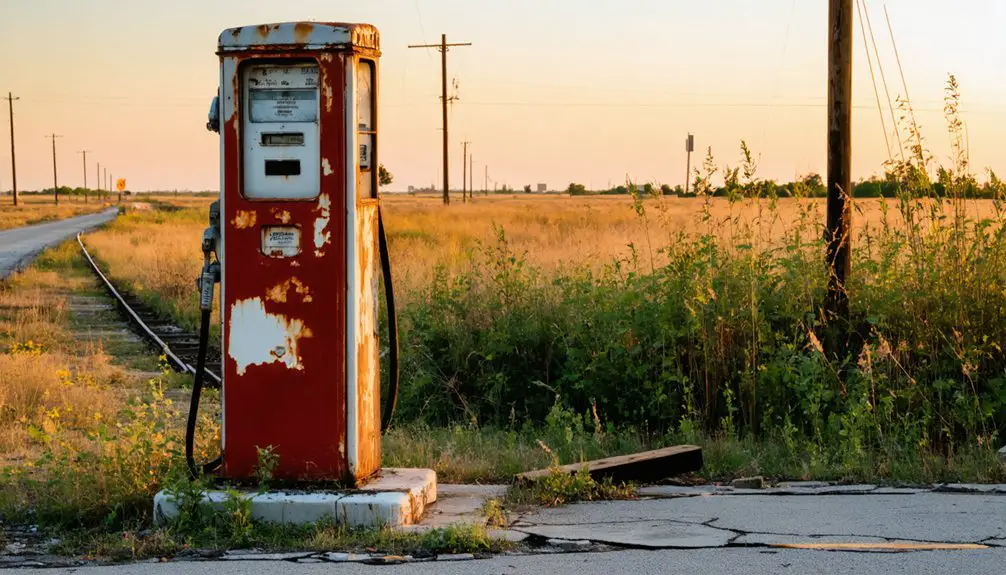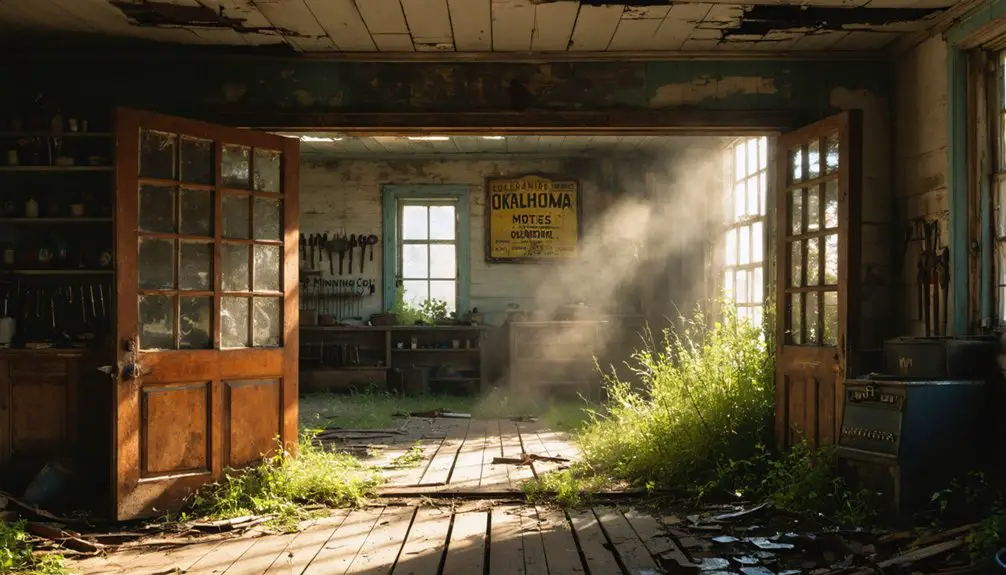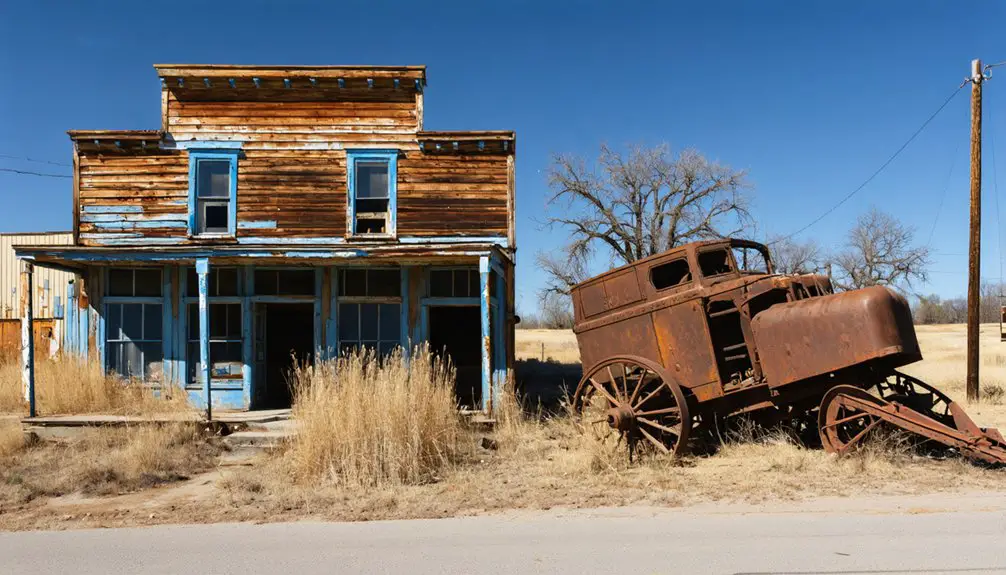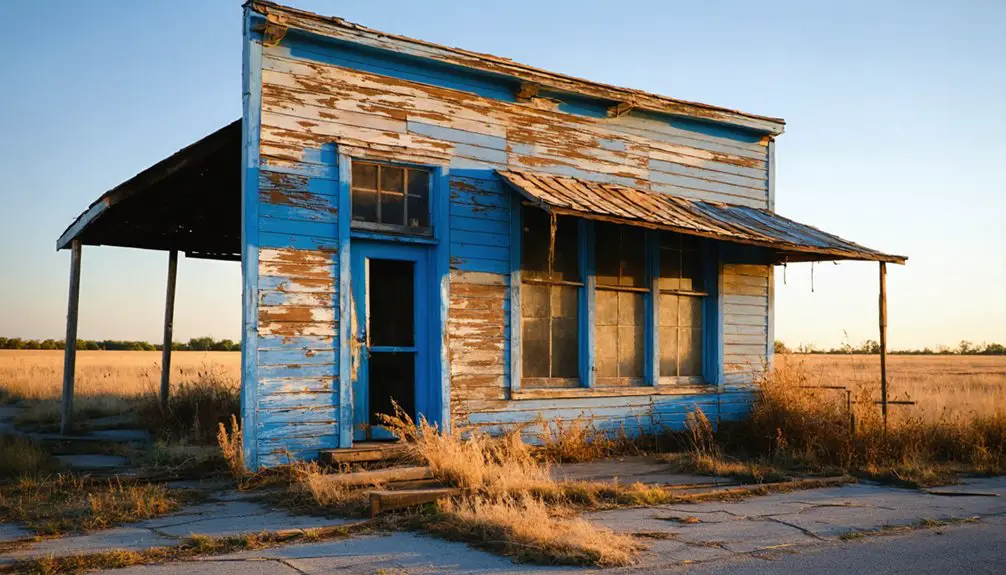You’ll find Kell City, Oklahoma’s ruins along the old Wichita Falls and Northwestern Railroad route, where Frank Kell and Joe Kemp established this frontier boomtown in 1913. The discovery of rich lead and zinc deposits transformed this railroad stop into a bustling mining community with thriving general stores, saloons, and worker housing. Today, only scattered foundations and toxic chat piles remain, telling a complex story of Oklahoma’s mineral wealth and environmental legacy.
Key Takeaways
- Kell City emerged in late 1913 as a railroad town established by Frank Kell and Joe Kemp around extensive switch-yards and commercial lots.
- The town served as a transportation hub following the Wichita Falls and Northwestern Railroad’s completion, supporting agricultural and mining activities.
- Early development featured cotton gins, cattle pens, and mining operations, with streets organized around industrial activities and workers’ housing.
- The town merged with nearby Eschiti to form Grandfield, marking a significant railroad-driven consolidation in Tillman County.
- Economic decline followed the collapse of mining operations, with environmental contamination and population exodus leading to abandonment.
The Rise of a Mining Frontier
As the early 1900s ushered in America’s industrial revolution, the Tri-State Lead and Zinc District emerged as a powerhouse of mineral production, stretching across northeastern Oklahoma into Kansas and Missouri.
You’d find yourself in the heart of the world’s largest zinc-producing region by 1915, where mining technology transformed from basic underground operations to more sophisticated surface extraction methods.
The district’s prominence skyrocketed as towns like Picher, Commerce, and Peoria sprouted from the mineral-rich earth. Given its multiple locations, Picher’s name appeared across different geographical points in the mining region.
Mining wealth transformed the landscape as boomtowns emerged, drawing thousands to seek their fortunes in the mineral-laden soil.
While the environmental impact wasn’t yet fully understood, the region’s mines yielded over $1 billion in minerals between 1850 and 1950.
During World War I, you’d witness the district’s vital role in supplying over half the nation’s lead and zinc, powering America’s industrial might and defense capabilities.
The rapid development brought significant economic growth as new towns and businesses emerged throughout the region due to the financial gains from mining operations.
Early Settlement and Town Planning
You’ll find Kell City’s origins firmly rooted in its strategic railroad placement, where Frank Kell and Joe Kemp secured a 500-foot wide right-of-way from the U.S. Government across the Big Pasture.
The town’s layout centered around extensive railroad switch-yards and sidings, with carefully planned lots surrounding these facilities to maximize commercial potential. The early development mirrored other successful railroad towns like Elk City, which saw regular train service established quickly after rail completion. By 1907, the Wichita Falls and Northwestern Railroad bypassed Eschiti by two miles, cementing Kell City’s position as a key transportation hub.
The early infrastructure included cotton gins and cattle pens along the main thoroughfare, establishing Kell City as an essential agricultural hub that directly competed with nearby Eschiti for regional prominence.
Initial Mining Town Layout
The hastily established mining town of Kell City emerged in late 1913 following the discovery of valuable lead and zinc deposits on Harry Crawfish’s allotment.
You’ll find that the town layout developed organically around the mining operations, with streets and infrastructure designed primarily to serve the bustling mining industry. The entire settlement sat atop a network of underground mine tunnels, which would later prove problematic for the town’s future. The area became renowned as the most productive field in the Tri-State District.
Mining shafts dictated the placement of both commercial and residential areas, with workers’ housing clustered near mine entrances for convenience. The region’s rich mineral deposits were crucial in manufacturing World War ammunition.
The business district formed along the main thoroughfares, though minimal zoning separation existed between commercial and residential areas. An extensive interurban trolley system connected workers to neighboring mining communities, serving as the town’s lifeline for both passenger and freight transport.
Population Growth and Development
While other Oklahoma settlements struggled to gain traction in 1907, Kell City sprang to life alongside the newly extended Wichita Falls and Northwestern Railroad, transforming empty prairie into a bustling frontier town.
The settlement patterns centered around the railroad’s strategic placement, with Frank Kell and Joe Kemp actively promoting townsite lots to enthusiastic settlers. Similar to Elk City’s rapid growth that saw over 60 businesses established by 1902, Kell City experienced remarkable commercial expansion. The area’s early settlers faced land claim requirements of living on their plots for 14 months before purchasing at $1.25 per acre.
You’ll find Kell City’s growth was driven by these key factors:
- Railroad switch-yards and sidings provided essential industrial infrastructure
- Cotton gins and cattle pens supported the local agricultural economy
- Competition with nearby Eschiti (just two miles away) spurred development
- Strategic location along government-granted right-of-way across Big Pasture
- Blend of Texas ranchers, merchants, and railroad workers formed the population base
The town’s layout reflected its commerce-focused purpose, integrating cattle and cotton facilities with railroad access.
Natural Resources and Economic Development
Natural resources fueled Kell City’s meteoric rise and eventual downfall during Oklahoma’s early resource boom years.
Like countless boomtowns before it, Kell City’s fortunes rose and fell with Oklahoma’s fickle natural resource wealth.
You’ll find the town’s story deeply rooted in coal, minerals, and the transformative power of oil discoveries that sparked rapid development in the early 1900s. Poor resource management and lack of economic diversification left the community vulnerable when these finite resources began to deplete. Like many of Oklahoma’s two thousand ghost towns, Kell City’s fate was sealed by resource exhaustion and economic decline.
The town’s strategic location near mining sites and along crucial railroad routes initially promised lasting prosperity. You can trace how oil companies shaped Kell City’s growth, bringing waves of workers and spurring quick construction of housing and businesses. The town’s eventual decline led its residents to migrate to Grandfield for new opportunities.
But when the mines emptied and oil production declined by the 1920s-30s, the town’s fate was sealed. Railroad service dwindled, businesses closed, and residents sought opportunities elsewhere.
Daily Life in a Mining Community
Mining families in Kell City endured challenging living conditions shaped by company control and economic dependence.
You’d find yourself living in a modest wooden company house, with your rent automatically deducted from your mining wages. Your daily schedule revolved around the mine’s demanding shifts, while facing constant health risks from coal dust and unsafe conditions.
- You’d gather with neighbors at local church services and community halls, finding strength in shared experiences.
- Your children would attend the local school, though attendance often depended on family finances.
- You’d shop at company stores using scrip, limiting your purchasing freedom.
- Baseball games and community dances offered rare moments of joy.
- You’d supplement your family’s diet through small vegetable gardens and livestock.
Transportation and Infrastructure

Three major transportation shifts shaped Kell City’s rise and eventual decline as a mining settlement.
You’ll find that railroads initially established the town as one of the region’s essential transportation hubs, bringing post offices and economic vibrancy in the early 1900s. When Kell City merged with Eschiti to form Grandfield, it reflected the era’s railroad-driven consolidation that you’d see across Tillman County.
The arrival of Route 66 in 1926 marked the second shift, creating new opportunities beyond rail dependence.
But it’s the third shift – the 1957 highway bypass – that dealt the final blow. The infrastructure evolution from rail to automotive transit left Kell City isolated, much like other Oklahoma ghost towns you’ll discover dotting the landscape, their abandoned buildings evidence to changing times.
The Peak Years: Growth and Prosperity
During the early 1900s, Kell City blossomed into a vibrant hub of commerce and community life, with several hundred residents calling this bustling mining settlement home.
You’d have found a town pulsing with energy, where coal mining drove prosperity and attracted ambitious settlers seeking their fortunes in Oklahoma’s resource-rich terrain.
The town’s peak years brought remarkable developments that shaped daily life:
- Thriving general stores, saloons, and merchant shops lined the streets
- Schools and churches fostered strong community cohesion among mining families
- Local celebrations, including dances and fairs, created lasting bonds between neighbors
- Mining operations provided steady employment and attracted skilled workers
- Supporting businesses emerged to serve the growing population’s needs
The spirit of independence and opportunity defined this dynamic period, as residents built a self-sustaining community in the heart of mining country.
Decline of the Mining Industry

The prosperous days of Kell City wouldn’t last forever, as Oklahoma’s once-mighty mining industry began its steady descent in the late twentieth century.
You’d have witnessed a dramatic economic decline as coal production plummeted from 5.73 million tons in 1981 to a mere 375 tons by 2021. The mining challenges proved insurmountable: depleted high-grade ores, rising extraction costs, and falling world prices forced companies to shutter their operations.
The town’s fate mirrored the broader collapse of Oklahoma’s mining sector, which lost 33% of its jobs since 2019.
Where once the sound of machinery echoed through bustling mines, silence fell as companies merged, consolidated, or simply closed their doors.
Even the promise of waterway transport couldn’t save the industry from its inevitable downturn.
Exodus and Abandonment
You’ll find that Kell City’s path to becoming a ghost town began not with mining’s decline, but rather with broader economic shifts in early 20th century Oklahoma.
Mining Jobs Disappear Fast
As World War I drew to a close, Kell City’s once-thriving mining industry faced a devastating collapse that would permanently alter Oklahoma’s economic landscape.
You’d have witnessed the rapid disappearance of jobs as mining companies refused to unionize, crushing workers’ hopes for job security. Labor disputes intensified as the oppressive company-town system crumbled, leaving miners without stable employment or housing options.
- Mining activity plummeted between 1916-1921, devastating local families
- Railroad monopolies like MK&T prioritized profits over worker welfare
- Company owners’ resistance to unions accelerated job losses
- Rising costs of sulfur removal made coal mining unprofitable
- Agriculture couldn’t absorb the displaced mining workforce
The mine closures that followed transformed Kell City from a bustling coal town into another Oklahoma ghost town, its workers scattered in search of new opportunities.
Population Shifts After 1930
Mining’s collapse sparked a population exodus that transformed Kell City after 1930, turning a once-vibrant community into little more than scattered ruins.
You’d have witnessed a dramatic rural migration as young residents sought opportunities in Oklahoma City and Tulsa, never to return. The town’s lifeblood drained away as Route 66 traffic diverted to Interstate 40, and the railroad’s importance diminished.
Community disintegration accelerated when essential services vanished – the post office closed, schools consolidated elsewhere, and local businesses shuttered.
Without a stable tax base, remaining public services crumbled. Churches and social clubs that once bound neighbors together dissolved as aging residents passed on without replacement.
The transformation was complete: geographic isolation, coupled with the gravitational pull of urban amenities, sealed Kell City’s fate.
Families Leave Mining Life
The harsh realities of company-controlled mining life ultimately drove families from Kell City’s once-thriving community in the mid-20th century.
You’ll understand why family migration became inevitable as mining hardships intensified and environmental concerns grew.
- You’d find your paycheck was often “bob-tailed,” leaving you in debt to company stores where you could only spend scrip.
- Your children faced health risks from lead and zinc contamination in soil and water.
- You’d worry about dangerous abandoned mine shafts near your home.
- Your family lived under strict company control with minimal amenities.
- You couldn’t own your home or build lasting roots due to complex land lease arrangements.
As mining profits declined after the 1920s, you and your neighbors sought freedom from corporate control, better living conditions, and more stable economic opportunities elsewhere.
Archaeological Remains Today
Located within Oklahoma’s historic mining region, Kell City’s archaeological remains paint a compelling portrait of frontier abandonment through its partially standing structures and scattered ruins.
You’ll find building foundations and mining remnants emerging from vegetation overgrowth, while artifact analysis reveals layers of human activity stretching back to Archaic times.
Though preservation challenges persist due to erosion and past unauthorized digging, the site now enjoys legal protection from further disturbance.
The ghost town’s archaeological significance extends beyond its visible ruins.
While crumbling walls tell one story, the true historical wealth lies buried beneath Kell City’s weathered surface.
Scattered pottery shards, mining equipment, and tool fragments tell the story of daily life in this once-bustling community.
Local archaeological societies have salvaged vital artifacts, ensuring these pieces of Oklahoma’s mining heritage continue to educate future generations about the region’s boom-and-bust cycle.
Legacy in Oklahoma’s Mining History

Oklahoma’s lead and zinc mining transformed Kell City and its neighboring communities into bustling economic powerhouses, with the region producing more than half the world’s zinc output by 1915.
You’ll find that the mining industry’s impact stretched far beyond local boundaries, generating over $1 billion in mineral wealth between 1850 and 1950 while employing thousands of workers throughout northeastern Oklahoma.
The strategic importance of these mining operations became especially clear during World War I, when the region’s mines supplied more than fifty percent of the lead and zinc used in the American war effort.
Mining’s Economic Rise
During the late 19th and early 20th centuries, coal mining transformed Oklahoma’s economic landscape, steadily growing from modest beginnings of 100,000 tons in the 1870s to a remarkable peak of nearly 5 million tons by 1920.
You’ll find that mining technology advanced rapidly during this period, while labor movements gained strength as workers fought for better conditions.
Key developments that shaped Oklahoma’s mining boom:
- Coal output reached 3.5 million tons by 1903, valued at over $6 million
- Mining towns like McAlester emerged as essential economic centers
- Workers initiated strikes in 1894, demanding improved wages
- Lead and zinc production dominated global markets by 1915
- The Tri-State District became the world’s largest zinc producer, generating over $1 billion in mineral wealth
Resource Boom’s Lasting Impact
While the Tri-State Mining District once produced over $20 billion in lead and zinc ore, its legacy has left an indelible mark on Oklahoma’s landscape and communities.
You’ll find stark reminders of this era in the towering chat piles that loom over Kell City, containing millions of tons of toxic mining waste laden with lead and zinc contaminants.
These environmental impacts have devastated local water supplies and soil quality, forcing many families to relocate through state buyout programs.
Yet, you can still witness community resilience as some residents maintain hope for eventual cleanup and revitalization.
The district’s role in supplying critical resources during both World Wars shaped Oklahoma’s economic identity, even as the region now grapples with widespread contamination and the challenges of remediation that will span generations.
Frequently Asked Questions
What Were the Most Common Causes of Death Among Kell City Miners?
Like canaries in a coal mine, your mining ancestors faced deadly cave-ins and structural collapses, while toxic lead and zinc exposure brought chronic health hazards that poisoned their bodies through accidents and disease.
Were There Any Notable Crimes or Lawlessness Incidents in Kell City?
You won’t find documented crime reports or law enforcement incidents from this settlement. Historical records don’t indicate any notable lawlessness, which suggests it was likely a relatively peaceful frontier community.
What Indigenous Tribes Originally Inhabited the Land Where Kell City Was Built?
Like stars claiming their piece of sky, the Kiowa, Comanche, and Apache tribes held this land through the Medicine Lodge Treaty of 1867, until you’d find settlers arriving post-1901.
Did Any Famous People or Historical Figures Ever Visit Kell City?
You won’t find any records of famous visitors or historical figures stopping in this small town. Its historical significance remained local, without documented visits from well-known personalities of the era.
What Recreational Activities and Entertainment Were Available for Kell City Residents?
You’d have found mining recreation at local saloons, joined church gatherings for potlucks, enjoyed baseball games, participated in outdoor activities like hunting, and caught traveling shows at the community’s local entertainment venues.
References
- https://en.wikipedia.org/wiki/List_of_ghost_towns_in_Oklahoma
- https://www.youtube.com/watch?v=5d-wHDTIbb0
- https://www.okhistory.org/publications/enc/entry?entry=GH002
- https://kids.kiddle.co/List_of_ghost_towns_in_Oklahoma
- http://sites.rootsweb.com/~oktttp/ghost_towns/ghost_towns.htm
- https://www.okhistory.org/publications/enc/entry?entry=MI042
- https://en.wikipedia.org/wiki/Picher
- https://coal.okcounties.org/about
- https://conservation.ok.gov/aml-history/
- https://elkcitychamber.com/community/history-of-elk-city-oklahoma/



